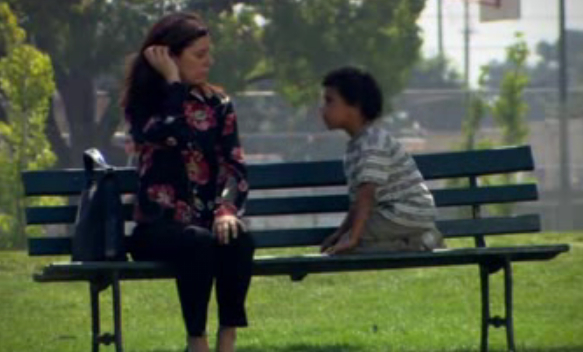Postmodernism announced the death of the subject, but recent developments in literature, philosophy and political agency suggest that it is alive and kicking as ever. Not in form of the modern Cartesian ego though and also not in denial of all the subjectivity-disrupting forces that postmodern theory pointed out. It returns with a great leap of faith, in a fragile moment of intersubjective trust and reveals characteristic traits that call for another vernacular, one that this webzine has come to describe as metamodern.[i]
“A prevalent discourse of a recent epoch concludes with its [the subject’s] simple liquidation”, states Jacques Derrida in an interview with Jean-Luc Nancy. The “recent epoch” Derrida is talking about is postmodernism, of course. And who would know better what postmodernism is about than the wizard of postmodern thought himself? In a discourse that casts doubt on the credulity of metanarratives, that questions the hermeneutics of meaning, the rational, self-contained subject of modernism has had a hard time indeed.For the subject at stake here, the subject allegedly liquidated in postmodernism, is the modern subject. Its beginnings can be traced back to sometime around the Renaissance and Reformation, but it is most commonly characterized in terms of the Cartesian Ego: it is strong, autonomous, reasonable and above all coherent. It has cast off determination by church doctrine and Christianity`s encompassing truths and instead goes for, as Heidegger puts it, “legislating for himself”[ii].
Postmodernism then dismantles and deconstructs all the grand-narratives and overriding truths, only this time this affects not only the grand-narrative of religion, but also the subject itself, whose status as a rational entity is seen as another grand-narrative. Backed by post-structural linguistics, the different postmodern/poststructuralist thinkers, such as Foucault, Althusser or Lacan, are taking a tough stance towards the subject and are exposing it as foreign-ruled, schizophrenic, instable, a field of discourses. The skepticism against metanarratives remains one of the greatest achievements of postmodern thinking, changing not only the face of philosophy, but influencing profoundly such fields as identity and gender politics, backing disability studies, triggering post-colonial studies and bringing the project of multiculturalism to life.
These achievements remain unchallenged. Nevertheless, over the last ten years, quite astonishing changes have happened, for instance in terms of discussing subjectivity in academia. Across a variety of disciplines – literary studies, philosophy, political theory and even psychology – calls for a rethinking of subjectivity can be heard. Publications dealing with “The return of the subject” or “The Self beyond the Postmodern Crisis“, suddenly become ubiquitous.
But also in literature, film, arts and political agency, we can witness a paradigm shift. The subject reappears and it comes with other dismissed categories such as trust, belief, coherence and even love. I would suggest that it reappears in a confined space that Peter Sloterdijk in his “Spherology” describes as a “Bubble” – an artificially created space, where in a human, intersubjective experience, the outside forces exposed by postmodern thinkers can be temporarily shut out.
In Performatism or The End of Postmodernism, the literary scholar Raoul Eshelman depicts a new kind of subject that establishes itself in spite of disruptive forces in an act of belief. This subject is a coherent self that re-introduces the possibility for identification, affection and selfhood, although not in a naïve, unreflective way.
Similarly, Karen Coats assures that there is no way the Cartesian Ego can return after all that was learned from Postmodernism – only to then sling the slogan “I love, therefore I am” into the arena of debate, calling for a rethinking of the concept of the Self, acknowledging the role of love in its construction. The writings of Lebanese-French author Amin Maalouf ask for a rethinking of the concept of identity describing it as an act of positive affirmation, which can include an attachment to a religion or land or ethnic group, while acknowledging the instability of identity as such. And even the great evangelist of postmodernism, Ihab Hassan, suddenly calls for an “Aesthetic of Trust”, where in a “world flow of ultimate mysteries”, the relation between subject and object can be redefined in terms of “profound trust”[iii].
As others have documented on this webzine, in literature as well as film or television, too, we suddenly come to meet characters who masquerade as coherent subjects. They are innovative figures who step into the scene with a quirkiness that, perhaps precisely because of their idiosyncratic authenticity, renders possible a new relation between literary hero and recipient. Furthermore, we experience a shift considering political agency: Wasn’t the subject of Postmodernism (as Slavoij Žižek doesn’t cease to remind us), essentially powerless in the workings of global capitalism? Then the symbol of the OccupyWallStreet-Protests, the fragile, yet brave and daring ballerina on top of the iron bull, definitely proves a new kind of political agent.
While all of the above mentioned fields are worth taking a closer look at, it is one artist that best exemplifies, for me, the parameters of the metamodern subject: Miranda July. Readers of this webzine might know July from James MacDowell`s articles on the “quirky” cinematic sensibility, in which MacDowell describes her self-starred movie “Me and You and Everyone We Know” as one of those post-millennial American indie comedies that convey a metamodern tone and feeling. This does not only apply to her films, however. Across the oeuvre of all-rounder July, we are confronted with moments in which bitter irony is paired to straight sincerity, fear to trust, and skepticism to optimism.
Central to all her fictional works are characters that can be described –euphemistically – as socially awkward. They are naïve to an extent that one wants to scream at them or simply turn off the TV or throw away the book; they are lonely and desperately looking for love; they are either leading terribly average lives or they are isolated and insecure to such an extent that any glimmer of optimism on their faces can only generate a feeling of pity in the spectator. Yet this doesn’t happen. July’s characters somehow manage to overcome the inescapable trap of postmodern discourse. With all their oddities, they develop a braveness and self-confidence that seems highly unreasonable, preposterous and odd in itself, but nevertheless works for them, enabling temporary, intimate relations with others that convey a great deal of beauty.
In the short-story The Sister, a sex-scene between two lonely old men is doomed by bitter skepticism, repulsion, insecurity and one man’s fear of contracting STDs. This being the “real” that postmodernists loved “rubbing observers’ our noses in“[iv], as Raoul Eshelman describes it. But the two men don’t end up being disrupted by the context, instead develop a fragile mutual understanding and emotional proximity, a space where the subject – for the time being – is safe from contextualization. It is an instance of the modern self that is stabilized despite a postmodern background.
The same strategy can be observed in the relationship between a young boy and an embittered art curator in Me and You and Everyone We Know. Their relationship starts in a chat room, where the infamous line: “I want to poop back and forth, forever” is featured. The forces of discourse just hail down on the two characters, but the sincerity of the little boy and the trust of the older woman manage to form a protective shield against outside forces, leading up to a scene that contributed to the “R-Rating” of the movie in the U.S. This scene shows us two subjects in a sphere where context can get no hold of them: The boy kisses the woman, kind and forward, and she smiles for the first time in the movie. Miranda July’s fiction is full of such moments of tender weirdness.
Her interactive sculpture Eleven Heavy Things similarly deals with this possibility of subjectivity despite a hostile, postmodern context in a very unique way. The Sculpture – originally built for the Venice Biennale and later moved to New York Union Square Park, features a square-white pedestal with black inscription, reading:
This is my little girl. She is brave and clever and funny. She will have none of the problems that I have. Her heart will never be humiliated. Self-doubt will not devour her dreams.
At first glance the sculpture recalls the modern subject. It is strong and capable, standing on solid ground. If we were still in the hey-day of modernism, the scripture on the socket supporting whoever stands on it could even be read as a kind of manifesto, a messianic promise. But that is not all there’s to it. While containing space for a belief in the subject, it just as strongly contains space for its dissolution in postmodern irony: self-doubt will not devour your dreams? Seriously? You are a field of energies at the best and a Nothing dissolved in discourse at the worst.
The artwork of Miranda July thus contains, I believe, both a modern and postmodern subjectivity and thus exemplifies the space where an ingenious, metamodern subject can show itself. In this restricted area the subject is characterized by fragile belief that cannot brush aside good old postmodern irony completely – which would dissolve the subject immediately – but keeps it at bay for the moment.The installation enables the creation of a space where love can exist again. As fragile and problematic as it might seem to shut out discourse, it is carried out carefully so it doesn`t fall back into a (modern) fanatic personal-cult.
It is this oscillation between the belief in what is written to be true and the consciousness of it being utterly unlikely that makes for the beauty of the artwork and reflects a feeling that may very well be called metamodern. It is a moment of trust and love despite the harsh reality. It possesses at the same time sincerity and irony. The installation provides us with contained hope that is accompanied by a twitch of melancholy.
The reemerged subject is not the old modern one. It contains no transcendental justifications. Concepts of identity, selfhood and subjectivity can always be dismantled and deconstructed. But while the awareness about this still rightfully persists, new times call us to acknowledge that the subject nevertheless appears, in moments of intersubjectivity, in reciprocal spaces of belief, trust and love.
[i] The concept of Metamodernism and my understanding of it, is drawn from articles on metamodernism.com and Vermeulen, Tim and Robin van den Akker (2010): Notes on Metamodernism, Journal of Aesthetics & Culture, Vol. 2, 2010 DOI: 10.3402/jac.v2i0.5677
[ii] Martin Heidegger, “The Age of the World Picture,” in: The Question Concerning Technology and Other Essays, Harper and Row, (1977), New York, p. 148.
[iii] Hassan, Ihab: “Beyond Postmodernism. Toward an Aesthetic of Trust“, in: Klaus Stierstorfer (Ed.), Beyond Postmodernism. Reassessments in Literature, Theory and Culture, de Gruyter (2003), Berlin and New York, p. 211.
[iv] Eshelman, Raoul: “Performatism, or The End of Postmodernism”, in: Anthropoetics – The Electronic Journal of Generative Anthropology, Volume VI, number 2 (Fall 2000/Winter 2001)
http://www.anthropoetics.ucla.edu/ap0602/perform.htm
Sources:
Coats, Karen: ”The Role of Love in the Development of the Self: From Freund and Lacan to Children’s Stories“, in: Paul Vitz and Susan Felch (Ed.), The Self Beyond the Postmodern Crisis, ISI Books (2006), Wilmington.
Eshelman, Raoul: “Performatism or The End of Postmodernism”, Davis Group (2008), Aurora.
Hassan, Ihab: “Beyond Postmodernism. Toward an Aesthetic of Trust“, in: Klaus Stierstorfer (Ed.), Beyond Postmodernism. Reassessments in Literature, Theory and Culture, de Gruyter (2003), Berlin and New York.
Lyotard, Jean-François:” The Postmodern Condition. A Report on Knowledge”, Manchester University Press (1984), Manchester.
Miranda July: “No one belongs here more than you”, Canongate (2007), Edinburgh.
Miranda July: “Me and You and Everyone We Know”, DVD 91 min, IFC (2005)
Sloterdijk, Peter: “Sphären/1. Blasen“, Suhrkamp (1999), Frankfurt a . Main.
Top image: courtesy Miranda July. Still from Me and you and everyone we know (2005). Lower image, left: courtesy Adbusters. Occupy-poster What is your one demand? Lower image, right: courtesy Lukas Wassmann. Photo Eleven Little Things.




I thought Heidegger admitted we are consigned to a reality constituted via the kind metaphysics emanating from the essence of language. This means we produce metaphysical meaning. We a metaphysic-producing beings.
reading hegel you will understand that the signifier “subject” primarily signifies for the ability to process self-reference and just in case there is a misunderstandig: of course the empirical side of the “self” is never the same. it’s self-referntial process in time. [there is a difference in between the mere “logic” of the self and its empirical existence. they are simply two different “levels” of the same complex.] having that said i don’t see how you would “dismantle and deconstruct” this idea without ending up in an aporia yourself. the closer you come to the line that is marked by propositions such as “there is no self”, “there is no truth” you destroy your own possibility to speak free from an initial self-contradiction; and by the way that is one of the problems that dissolved/dissolves “postmodernism” from the inside… most of its icons we stood constantly too close to that line… causing an intellectual heartburn.